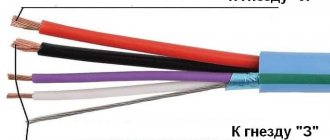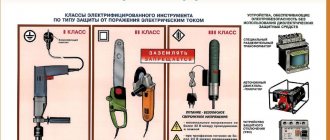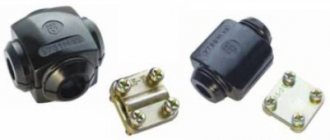Electrical hand tools, or simply power tools, include power tools with an electric drive motor. The range of such devices is quite wide; they are used to perform various operations.
Testing of portable power tools to safety standards should be carried out on a regular basis. Power tools are typically held in the hands during operation and therefore pose a potential electrical hazard.
Power sources for power tools can be:
- industrial frequency electrical networks with voltages of 380, 220, 110 volts;
- high-frequency current sources designed to power power tools of the corresponding type;
- DC sources - batteries, rectifiers and converters.
Regulations
The conditions for safe operation and testing of power tools are regulated by the “Rules for labor protection when working with tools and devices”, approved by order of the Ministry of Labor and Social Protection of the Russian Federation No. 835n dated November 27, 2020.
In accordance with the Rules, power tools are divided into the following safety classes:
- Class 0 includes power tools in which only basic insulation serves as protection against electric shock without connecting exposed conductive parts to the protective neutral wire;
- Class 1 is assigned to instruments in which, in addition to basic insulation, protection is provided by connecting exposed conductive parts to a protective conductor;
- power tools of the 2nd safety class have double or reinforced basic insulation;
- Class 3 is represented by instruments powered by ultra-low voltage sources not exceeding 50 volts.
In addition, any mechanized tool, including electric, must comply with the requirements of the technical regulations of the Customs Union TR CU 010/2011 “On the safety of machinery and equipment.”
Power tools powered by alternating current voltage from 50 to 1000 volts and direct current from 75 to 1500 volts inclusive are classified as low-voltage devices. The rules for their operation are regulated, in addition to the above-mentioned documents, by the technical regulations TR CU 004/2011 “On the safety of low-voltage equipment.”
Portable grounding up to 1000 volts
For these types of grounding, grounding conductors with conductors with a cross-section of 16 sq. mm are provided. These brands include:
- PZRU-1 is designed to protect workers who work on live parts of electrical installations with voltages from 0.4 - 1 kV. Solid duralumin grade D16 is used. The terminals are in good contact with the wires and have a simple design; they can also be applied to inclined wires. In this case, the conductors are highly flexible, copper, stranded, transparent PVC insulation. The device also has a steel spring, which is located between the wire and the terminals, thereby preventing damage. The design has a specially selected rod that matches the size.
- ZPL-1 – portable grounding for overhead lines up to 1 kV. The cross-section of conductors in this type can be from 35-95 sq. mm, in single-phase or three-phase versions. This device is also equipped with a rod, which is coated with powder paint and a tube that protects against thermal effects.
- ZPP-1 – for distribution devices. This design is of a three-phase type with three rods, the cable cross-section varies from 25-95 sq. mm. The terminals are made of aluminum and are attached to the wire using copper sleeves.
The best manufacturers of sockets and switches for your home. TOP most purchased, according to buyers.
Grounding
Electrical tool tests carried out for certification purposes
To carry out the circulation and operation of electrical tools related to low-voltage equipment in the territory of the Customs Union, it is necessary to have a certificate of conformity TR CU 004/2011. The certification process involves testing a batch or individual samples of equipment. Tests are performed by a laboratory included in the Unified Register of Certification Bodies of the Customs Union.
Certification tests are carried out to establish compliance of low-voltage equipment with the following safety requirements:
- providing the necessary level of protection against electric shock from direct and indirect contact;
- no increased risk of injury from elevated temperature, traumatic effects of electric arc or radiation during operation;
- a sufficient level of mechanical protection against injury from both rotating and stationary parts of the equipment.
In addition, the certified equipment must not be a potential source of fire, both in normal and emergency modes.
How are periodic tests and inspections of hand-held power tools organized?
During operation, the following must be inspected and tested at least once every six months:
- electrically powered hand tools in use;
- devices used to power power tools - step-down transformers, frequency converters, etc.;
- power cables – extension cords and protective switching equipment installed in the power supply circuit of power tools.
Only serviceable and duly tested power tools may be allowed to operate. It is not permissible to operate tools with damaged power cables, smoke emission, destruction of the housing and the presence of an all-round collector fire.
Electrical tool testing is carried out by an employee who has the appropriate electrical safety clearance group (at least III) and has an entry in the certificate in the column - carrying out special work “testing of electrical equipment with high voltage”.
The principle of testing electric tools for operation
It is necessary to understand that there are two types of activities: verification and testing of power tools. For each of them, a clear algorithm has been developed, which we will discuss below.
Verification is an event that is carried out by special certified laboratories. The methodology for this process is approved in the current instructions “Standards for testing power tools up to 1000V”. Periodic verification of electrical equipment includes the following steps: Determining the presence and serviceability of the grounding circuit using an ohmmeter. One end of the device is connected to the output on the plug, while the other is connected to ground on the instrument itself. If the ohmmeter reading exceeds 0.5 Ohm, the electrical equipment is considered unsuitable for further use.
Read also: Diode d18 precious metal content
Insulation integrity analysis . Determination of a violation of its integrity is carried out using a megger, as well as a power source. For an electric instrument with a maximum voltage of 50V, the analysis should be carried out up to 550 V, with a maximum voltage of 220 V up to 900 V, and higher up to 1350 V. The device readings during the test should not be lower than 500 kOhm. If the readings drop below, the electrical device is considered unfit for use. Trial test of an electrical appliance at idle.
Periodic verification of hand-held power tools takes place in one stage. The handle of the tool, which is suspended from a special wire, is lowered into a bath of water. The terminal of the test transformer is connected to the end of the wire, the second terminal is connected to the bath, having previously been grounded. The transformer supplies 10 kV with a frequency of 50 Hz, while the leakage current per 200 mm of the insulated part should not exceed 1 mA.
It is worth noting that all stages must last at least one minute.
An inspection is a periodic visual inspection, which is recommended to be carried out at least once every ten days. It is necessary to pay attention to the following criteria: integrity of the case, absence of chips and cracks; the integrity of the power cord, and for hand-held power tools, the absence of cuts and slits on the handle; the plug and its contact part so that there is no carbon deposits on it, the metal is not melted or adhering foreign substances.
Contents and standards of periodic tests and inspections
Scope of work performed during periodic testing and inspection of power tools
| Procedure to be performed | Suitability assessment criterion |
| Visual inspection | No visible damage |
| Checking the operation of the equipment in idle mode, performed for at least 5 minutes | Smooth operation without jolts or fluctuations in the sound tone emitted by the mechanism |
| Insulation resistance measurement. Performed with a 500 volt megohmmeter for 1 minute. The power tool switch is in the “On” position. | The minimum permissible insulation resistance value is 0.5 MOhm. Cordless tools are not assessed against this criterion. |
| Checking the integrity of protective grounding circuits. This procedure is performed only for instruments of the 1st safety class. | No circuit breaks. The value of grounding resistance is within the limits of the PUE standards. |
All of the above procedures are carried out in compliance with applicable regulations and local health and safety regulations.
Tool checking method
It is allowed to use household and industrial power tools that have passed the test. For this, a clear algorithm has been developed that must be followed by everyone who wants to work with it. In this case, you need to clearly understand the difference between verification and verification.
Verification is a test that is carried out in special laboratories located at every large enterprise. The tests include:
- Determining the presence and serviceability of the grounding circuit by using a special ohmmeter - one end of the device is connected to the terminal on the plug, and the other to the ground located on the tool itself. Measurements should show no more than 0.5 Ohm, which satisfies the safety conditions for using the tool.
- Measurement for the integrity and quality of insulation is checked with a megohmmeter at a voltage of no more than 500 V for a power tool designed for an operating voltage of 220 V. You don’t have to turn it quickly, this will be enough to see the insulation resistance of the tool. In this case, be sure to remember to press the button that turns on the electric tool. The device must show an insulation resistance of more than 500 kOhm; if this value is less, working with it is prohibited.
- Next, a trial test is carried out while idling for 5–7 minutes.
Power tools can also be tested with increased voltage. In this case, a tool with a voltage of up to 50 Volts is tested with a test voltage of 550 V. If the tool is designed for a voltage above 50 V, but with a power of up to 1 kW, the test voltage should be 900 V, above 1 kW - 1350 V. Tests are carried out within 1 minutes.
Verification is carried out by visual control and inspection. You need to check not only the housing, but also the cord connecting it to the power source. You need to pay attention to:
- The integrity of the body, there may be cracks and breaks.
- The power cable should not show any visible drying out, damage, chafing, or signs of burning or heating. Particular attention should be paid and checked at the points where the electrical cord enters the housing and the plug.
- The plug and its contact part, which will be connected to the network, are inspected and checked for integrity.
The check must be performed before starting work, and before turning it on after moving to another workplace. Naturally, professional laboratory verification is carried out only at large enterprises and firms; in everyday conditions, a worker should at least carefully inspect the power tool he picks up before work.
Read also: How to make a left zero in a private house
If we talk about the timing of the verification of power tools, then according to existing regulatory rules, periodic verification of the tool should be no less than every year, and it is necessary to check the power tool, as indicated earlier, before each use. If manual electrical equipment is used in extreme climatic and production conditions, it is recommended to check it with a megohmmeter at least once every 10 days.
Important point! When checking a tool at a factory, the first thing you need to look at is the date of the test. If the date has expired or there is no testing tag on the power tool at all, then it is prohibited to operate it - it must be removed and submitted for testing.
Registration of the results of periodic testing of portable power tools
To record the results of tests carried out, the enterprise must maintain a journal designed for this purpose. Keeping the log is the responsibility of the employee who is responsible for the good condition of power tools.
After the next test, the results are recorded in a journal. Each entry must contain the following information:
- date of testing or inspection of equipment;
- name of the instrument being checked and its inventory number;
- inspection results, tests, conclusion on suitability for use;
- date of the next test in accordance with the established frequency.
The housing of power tools, as well as supply transformers and frequency converters must be marked with the inventory number and the date of the next equipment inspection.
Electrical testing of power tools in the laboratory
Our company's certified laboratory has all the necessary human and technical resources to perform electrical tests and equipment inspections. Along with electrified tools, our laboratory tests PPE (personal protective equipment) and tests hand-held insulating tools used when performing work in electrical installations up to and above 1000V.
Among the advantages of our company are the following:
- for preliminary approval of the scope of work or on-site consultation, our specialist travels to the site free of charge;
- budgeting is carried out in a short time;
- in emergency cases, our electrical laboratory goes to the site on the day of the call;
- We work with customer sites throughout Russia;
- upon completion of work, the customer is provided with comprehensive reporting;
- consultations with our clients and potential customers are provided free of charge;
- Along with low prices for services, we provide discounts.
To order a service or get a consultation, contact our specialist on the website. You can call, place an order for a call back, write a message via online chat or email.
If there is a need to test, check power tools, personal protective equipment or hand-held insulating tools, this is the place for you.











